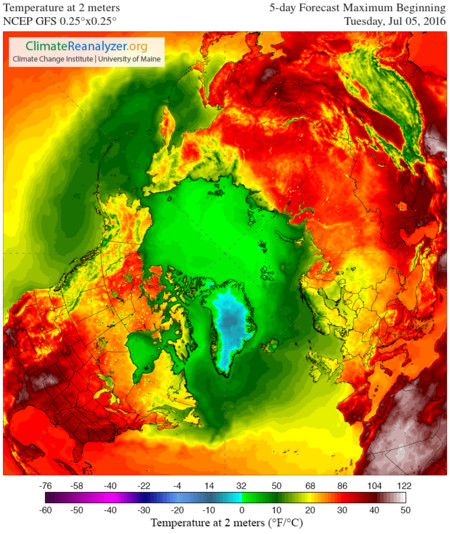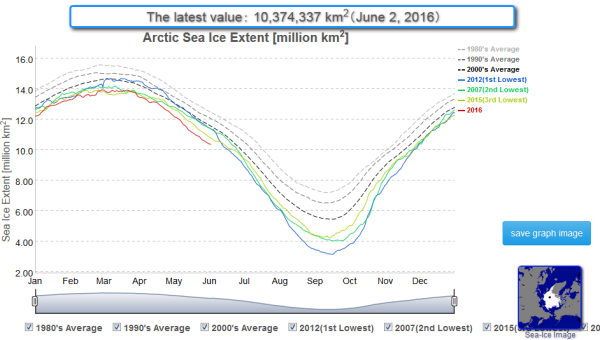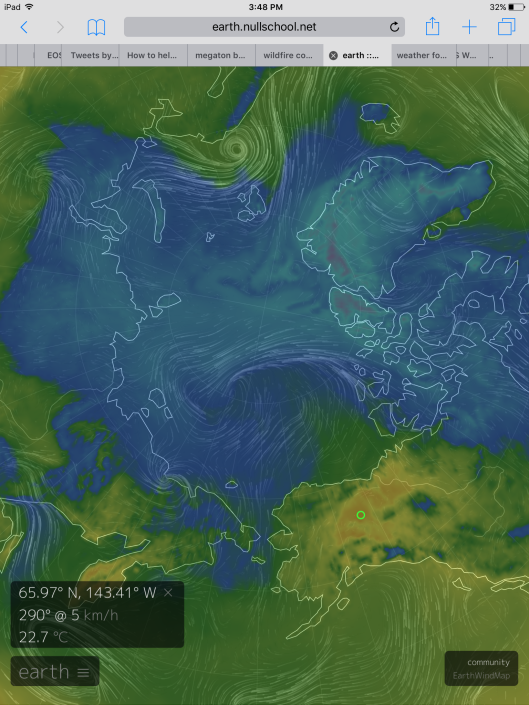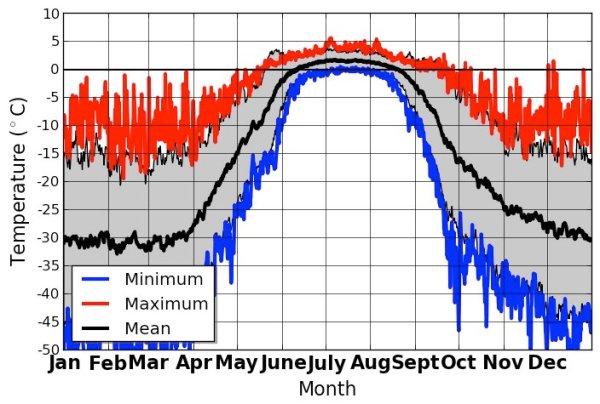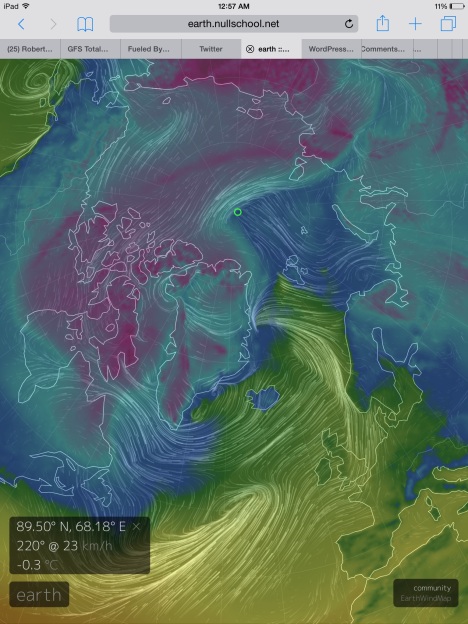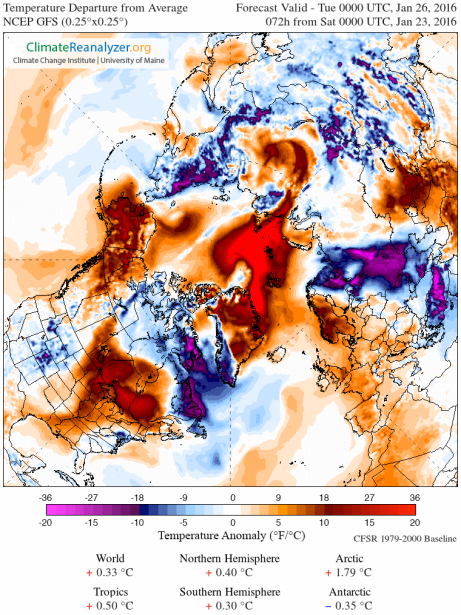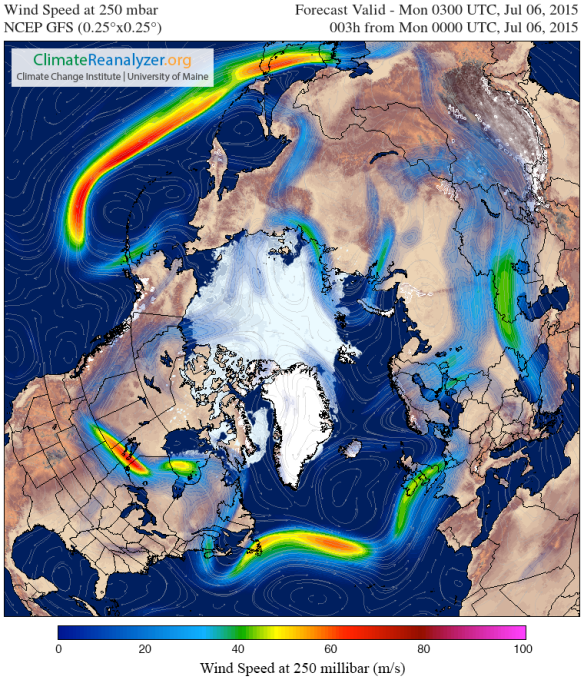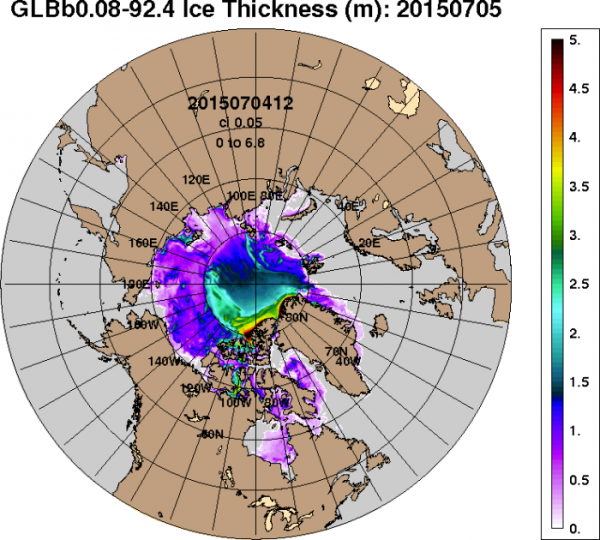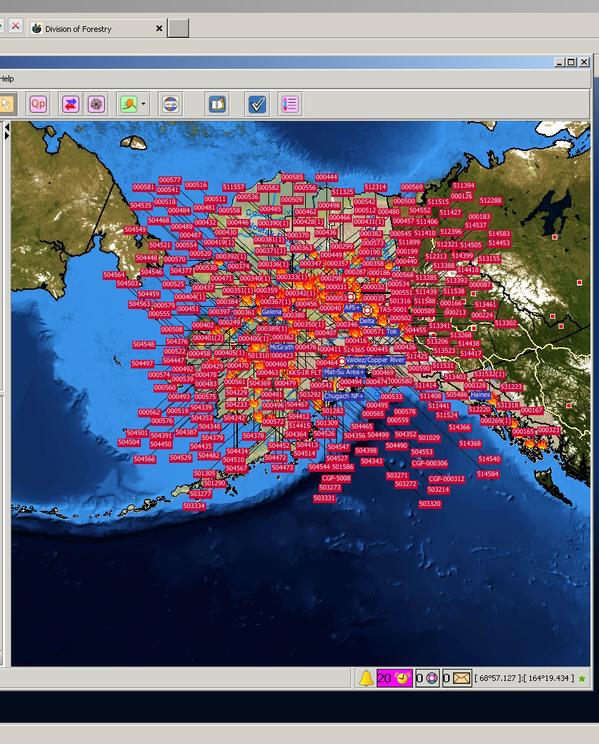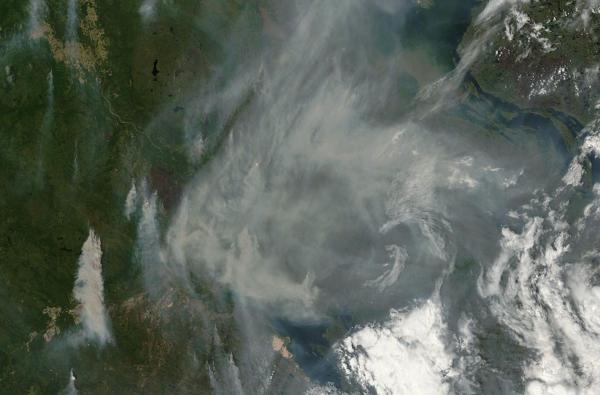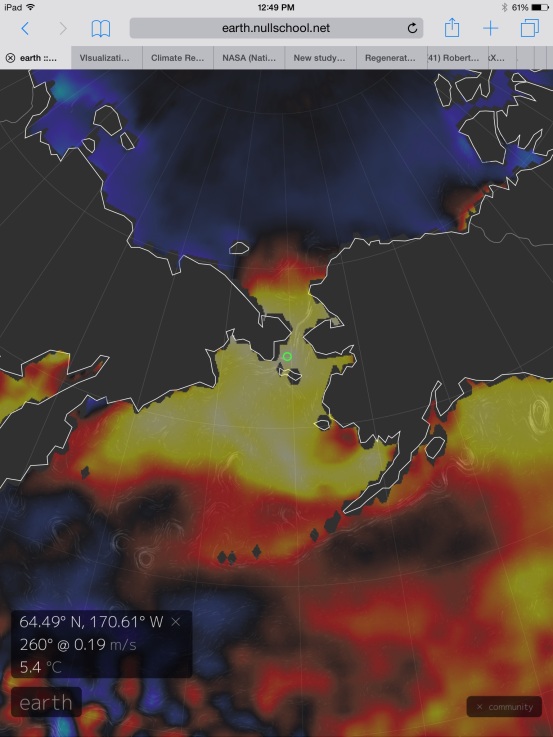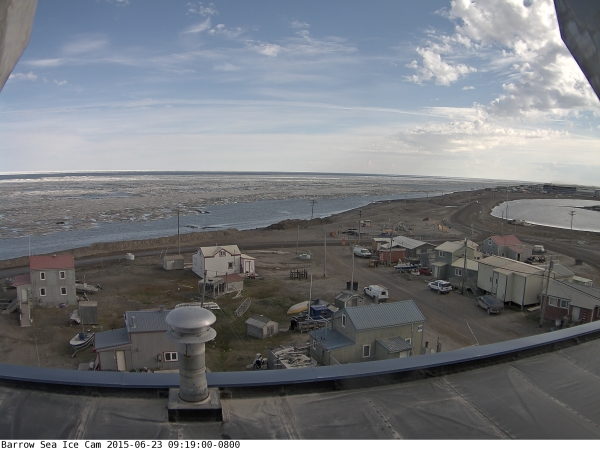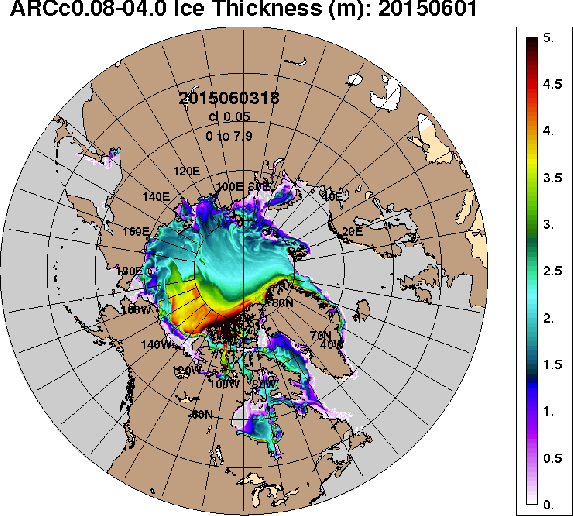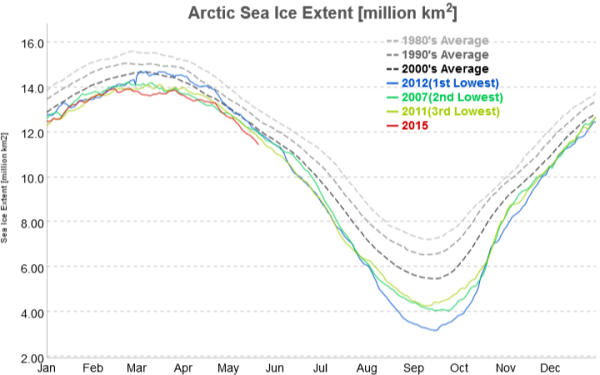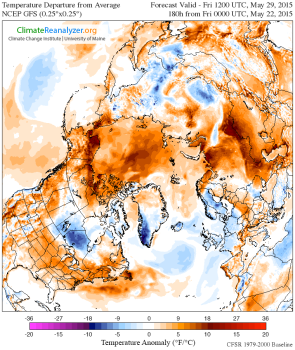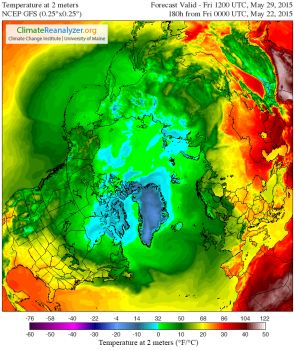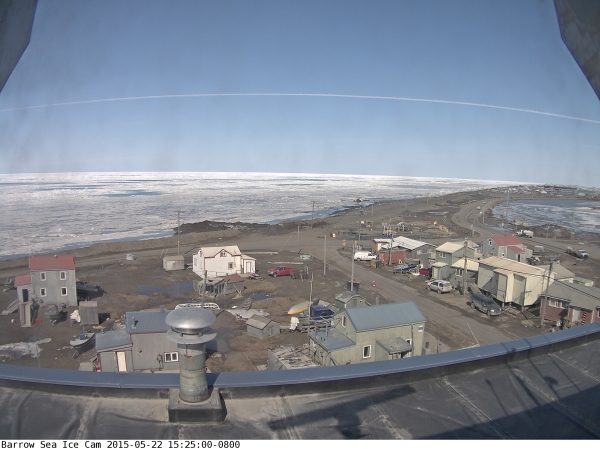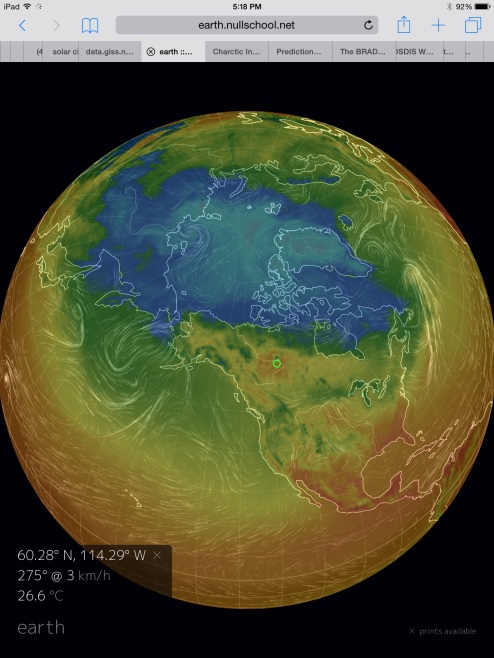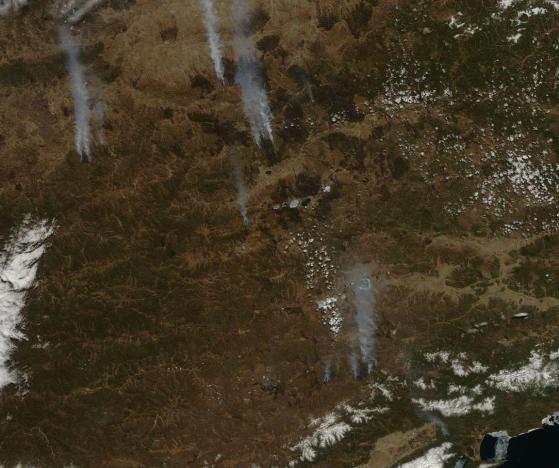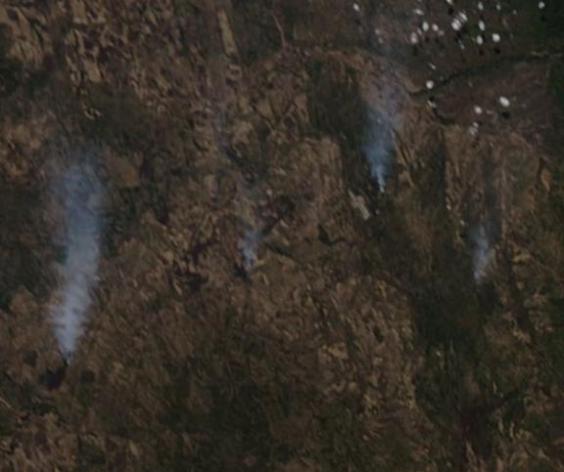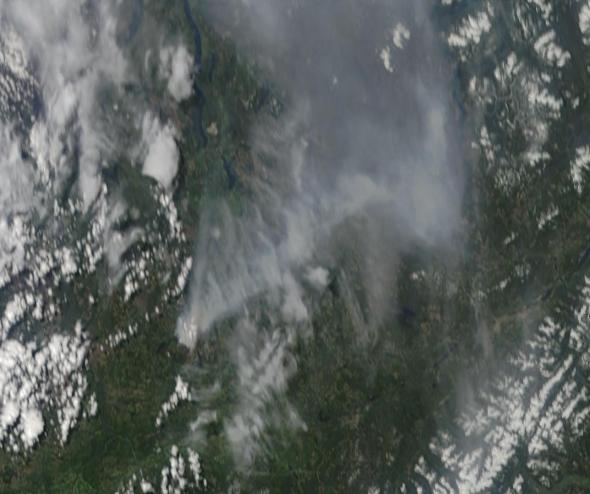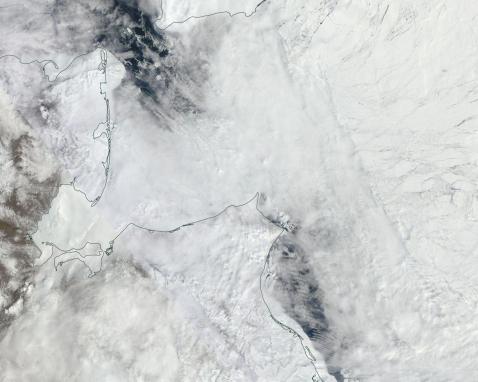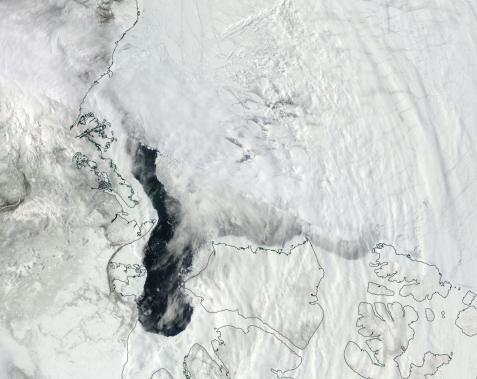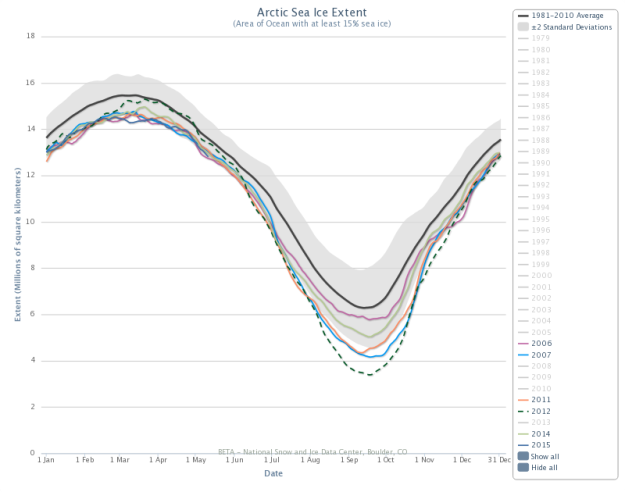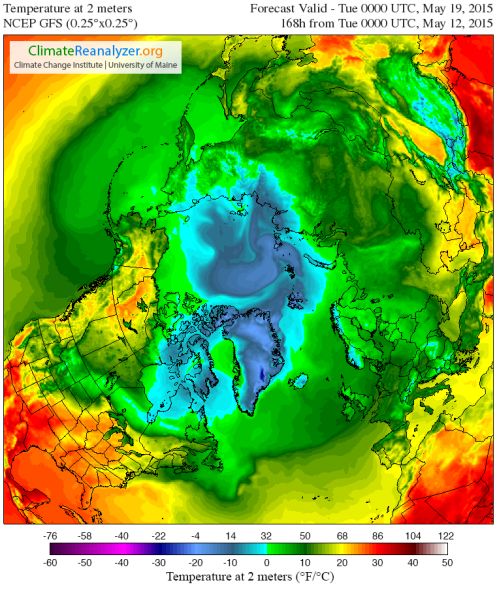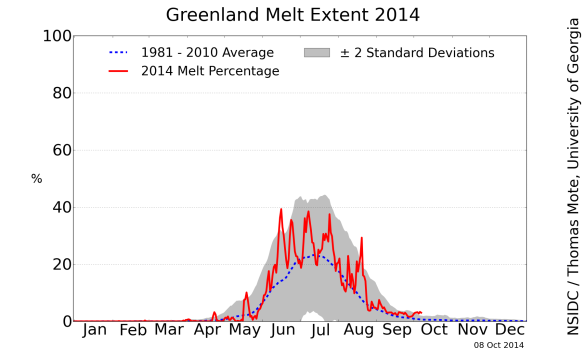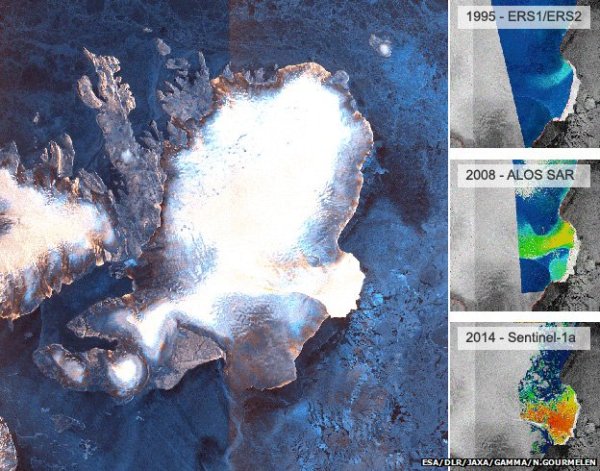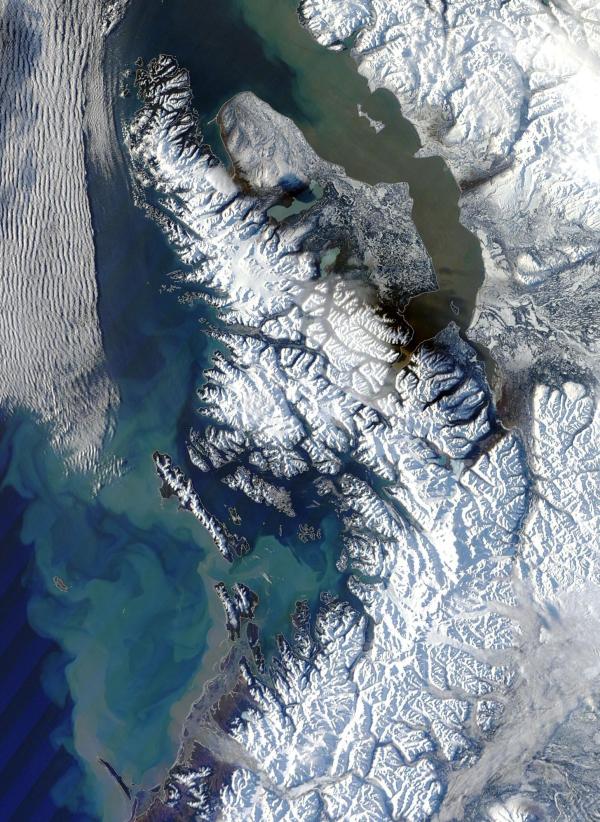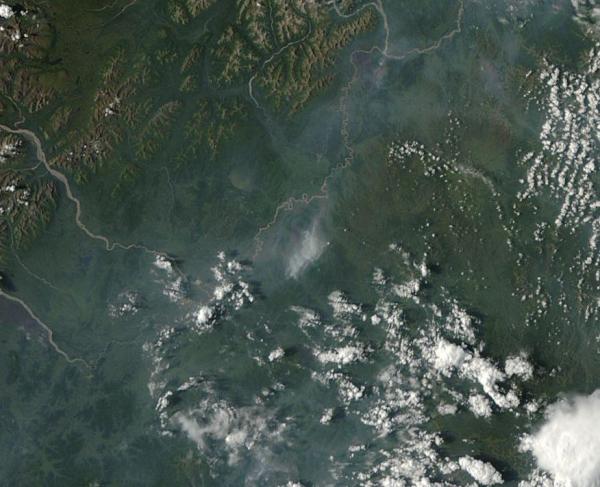Heat overburden at the roof of our world. It’s a dangerous signal that the first, worst effects of human-caused climate change are starting to ramp up. And it’s a signal we are receiving now. A strong message coinciding with a world-wide barrage of some of the worst January and February weather extremes ever experienced in human reckoning.
An Ongoing Arctic Heat Amplification
Ever since December, the Arctic has been experiencing what could well be called a heat wave during winter-time. Average temperatures have ranged between 2 and 7 degrees Celsius above normal winter time readings (1979-2000) over the entire Arctic basin. Local readings frequently exceed 20 degrees Celsius above average over large zones that shift and swell, circulating in a great cloud of abnormal warmth around the roof of the world.
Today is no different.

(Global Temperature Anomaly on March 4, 2014 showing a warmer than normal world sitting beneath an ominously hot Arctic. Image source: University of Maine.)
Average temperatures for the entire Arctic are 4.16 degrees Celsius above the, already warmer than normal, 1979 to 2000 base line, putting these readings in a range about 6 degrees Celsius above Arctic temperatures during the 1880s. When compared to global average warming of about .8 C above 1880s norms, this is an extreme heat departure that places the Arctic region well out of balance with both its traditional climate and with global climate at large.
Local large hot zones with temperatures ranging between 10 and 20 degrees Celsius above average appear east of Svalbard, in the Arctic Ocean north of the East Siberian Arctic Shelf, and over a broad swath of the Canadian Arctic Archipelago. These zones of warmth are as odd as they are somewhat horrific, creating regions where temperatures are higher than they would otherwise be in April or, in some cases, late May.
Sea Ice Melt Over a Warming Arctic Ocean
This ongoing condition of extreme Arctic heat is a symptom of overall Arctic amplification set off by a number of strong feedbacks now underway. These include sea ice measures that are currently at or near record low values (February saw new record lows in both extent and area measures) as well as a large and growing local emission of greenhouse gasses from polar stores long locked away by the boreal cold. Arctic geography also contributes to the problem as a thinning layer of sea ice rests atop an ocean that is swiftly soaking up the heat resulting from human warming.
During winter time, the combination of thin sea ice, warm ocean, and higher concentrations of greenhouse gasses generates excess warmth over and near the Arctic Ocean basin. The warmer waters, having trapped solar heat all summer long, now vent the warmth into the polar atmosphere through the sparse, cracked, and greatly diminished sea ice. And while this increasing heat imbalance has been shown to be lengthening the melt season by 5 days per decade, it is also stretching its influence well into winter time as ocean heat now continually bleeds through a thinning and ever more perforated layer of sea ice.
Other effects include an overburden of greenhouse gasses trapping long wave radiation to a greater extent in the polar zone while the already warmer than usual condition creates weaknesses in the Jet Stream that generate large atmospheric waves. The south-north protrusions of these waves invade far into the Arctic Ocean basin over Svalbard and Alaska, transporting yet more heat into the Arctic from lower latitudes.
The net effect is the extraordinary Arctic warming we are now seeing.
Earth Under Continuous Fire of Extreme Weather
This rapidly increasing warmth at the Arctic pole generates a variety of weather instabilities that ripple on through the Northern Hemisphere. Meanwhile, the ongoing impacts of equatorial warming or such warming in concert with the far-flung effects of polar amplification and an increase in the hydrological cycle of about 6% are causing a number of extraordinary events over the Southern Hemisphere.
In short, the barrage of extreme weather is now entirely global in nature. A brutal if amazing phenomena directly associated with a human-heated climate system.

(Map of extreme weather events throughout the world from January 1 through February 14. Note that it is now difficult to find a region that is currently not experiencing exceptional weather. Image source: Japanese Meteorological Agency.)
Over the western US, Canada, and Alaska, a Jet Stream ridge that has persisted for a year has generated both abnormally warm conditions for this region, with Alaska experiencing its third hottest January on record, and an extreme drought for California that is among the worst in its history. This drought is now poised to push US food prices up by between 10-15 percent as California officials are forced to cut off water flows to farmers.
Only the most powerful of storm systems are able to penetrate the ridge. And the result, for the US West Coast, is a condition that either includes drought or heavy precipitation and flooding events. A condition that became plainly apparent as winter storm Titan dumped as much as 5 inches of rainfall over drought-stricken southern California, setting off landslides and flash floods that sent enormous waves of water and topsoil rushing down roads and gullies alike. And though the storms came, the drought still remains.
Added to the list of extremes for the Western US are a number of early starts and/or late ends to fire seasons with California, Arizona and New Mexico all experiencing wildfires during the period of December through February.
Moving east, we encounter the down-sloping trough that is the flip side of the ridge bringing warmth and drought to deluge conditions to the west. So, for the Eastern and Central United States, we see the transport of chill air down from the Arctic Ocean, over Canada and deep into a zone from The Dakotas to Texas to Maine. As a result, we have seen winter storm after winter storm surge down into these regions, dumping snow, ice, and heavy rain while occasionally coming into conflict with Gulf warmth and moisture to spark tornadoes and thunderstorms over snow-covered regions.
One cannot separate the warm air invasion over Alaska and the heat radiating out of the perforated sea ice from the numerous polar vortex collapse events that have led to this extreme winter weather over Central and Eastern parts of the US. And so, it is also impossible to ignore the warping and deleterious impacts of human-caused climate change on the world’s weather.
The World Meteorological Organization (WMO), in its latest extreme weather assessment notes:
In the winter a deep reservoir of cold air becomes established through the atmosphere over the Arctic because of the lack of sunlight. This is usually held over high latitudes by the Jet Stream, a fast moving band of air 10 km up in the atmosphere which drives weather. This year, a “kink” in the jet stream allowed the reservoir of cold air to move southwards across the USA. A blocking pattern meant it was locked into place, keeping severe weather systems over much of the Eastern United States extending down to northeast Mexico.
This ‘kink’ and related blocking pattern the WMO mentions is also the leading edge of the advance of cold Arctic air over the North Atlantic which combined with ocean heat and moisture to aim intense storms at Western Europe. In essence, a powerful planetary wave or Rossby Wave type feature:

(The Northern Hemisphere Jet Stream takes on Planetary Wave pattern with an extreme high amplitude ridge over the Western US, Canada, Alaska and the Beaufort Sea and a deep, cold trough digging into the Eastern US and spreading out over the North Atlantic on February 26th. Image source: University of Washington.)
For as we look yet further East we come to a North Atlantic Ocean that has been little more than the barrel of a gun firing a two and a half month long barrage of storms at England and Western Europe. For the Jet Stream, at this point, is intensified by Arctic air fleeing from a warming north coming into contact with the also warming waters of the North Atlantic. In this region, the planetary wave feature developed with severe and lasting consequences for England, France, Portugal and Venice.
The upshot was the wettest period in over 250 years for England as well as the windiest period since at least the 1960s. During February, two of these storms generated 80-100 mph winds and waves off Ireland and the UK that were the highest ever recorded for this region. Meanwhile, the powerful storm surges associated with these storms reshaped the English coastline, uncovered bombs dropped during World War II and unearthed the stumps of an ancient forest that spread from England to France before it was buried in the floods of glacial melt at the end of the last ice age. The battering continues through early March with England suffering losses in excess of 1 billion dollars.
The storms ripping across the Atlantic also resulted in the loss of over 21,000 sea birds and have heavily impacted France, Spain and Portugal with record rains, gales and tidal flooding. During early February, a series of gales also drove high tides along the coast of Italy and spurred flooding in Venice.
As storms slammed into coastal western Europe, strange fires were also burning along Arctic shores as a very dry and windy winter sparked blazes along the coastlines of Norway. These fires, some of the worst in Norway’s history, occurred during January and February, months that have never seen wildfires before. So the strange story of flood and fire that tends to come with climate change may seem yet more radical and extreme when we include what has happened over this section of Europe during 2014.
By the time we enter Eastern Europe, Turkey, Jordan, Israel and Russia we again encounter an up-slope in the Jet Stream along with related periods of heat and drought. Record highs were set throughout a zone from Germany to Slovenia to Russia. Germany experienced January temperatures that were 2.8 degrees Celsius above the 20th Century average while Russia experienced heat anomalies approaching 10 degrees Celsius hotter than normal that persisted for up to a week in length. In Turkey, farmers frantically drilled into drying lake-beds for water as both warmer and drier than normal conditions combined with ground water depletion to generate severe agricultural stress.
But the strain for Israel, which experienced lowest ever winter rainfalls and one of the worst droughts in its history, was far worse. According to the Israeli Water Agency’s March 4 Statement, water supplies across the country were now at record low levels:
“Such low supply during this period has never before been documented and is unprecedented in Water Authority records,” the agency said. “The negative records broken in February are much more dramatic and significant than those of January.”
Drought-stressed Jordan has also been forced to ration water supplies, with rainfall levels now only 34 percent of that received during a typical January and February.
Abnormal warmth and drought also extended into China as most parts of the ancient empire received between 50-80 percent below average rainfall. Temperatures averaged over the entire country were the warmest seen since at least 1961. The warmth and dryness resulted in record low river and lake levels across the country with China’s largest lake turning into a sea of cracked mud and grasses.
In Singapore and nearby Malaysia, a two month-long heatwave is now among the worst ever recorded for this region. The situation has been worsened as nearby forest fires have combined with industrial pollution to produce a kind of all-encompassing smog. A nasty brew that cut visibility in the region to less than one kilometer.

(Smoke and smog from fires and industrial activity visible over Singapore and Malaysia. Image source: Lance-Modis.)
One would think that, with major heat anomalies occurring over the Arctic, the far removed Southern Hemisphere would be somehow insulated from impacts. But whether from far-reaching Arctic influence or simply from other factors related to human-caused climate change, austral regions were among the hardest hit by the, now global, spate of extreme weather events.
Australia’s record 2013 heatwave didn’t miss a beat as a hottest ever summer continued on through January and February. A period in the middle of January showed exceptionally severe high temperatures with World Meteorological Agency reports noting:
One of the most significant multi-day heatwaves on record affected southeast Australia over the period from 13 to 18 January 2014. The major area affected by the heatwave consisted of Victoria, Tasmania (particularly the western half), southern New South Wales away from the coast, and the southern half of South Australia. Over most parts of this region, it ranked alongside the heatwaves of January-February 2009, January 1939 and (from the limited information available) January 1908 as the most significant multi-day heatwaves on record.
A number of site records were set during the summer, including:
• Melbourne had seven 40ºC days; annual average is one day
• Adelaide had 11 days of 42ºC or above; annual average is one day
• Canberra had 19 days of 35ºC or above; annual average is 5.4 days
While Australia was sweltering under its hottest summer on record, south-central Brazil was suffering its worst-ever drought. By mid February, Brazil had been forced to ration water in over 140 of its cities. The result is that neighborhoods in some of Brazil’s largest cities only receive water once every three days. During this, extraordinarily intense, period of heat and dryness, untold damage was done to Brazil’s crops. But, by early March, a doubling of prices for coffee coming out of Brazil gave some scope to the damage. January was also Brazil’s hottest on record and the combination of extreme heat and dryness pushed the nation’s water reservoirs for southeastern and west-central regions to below 41 percent of capacity driving utility water storage levels to a critically low 19 percent.
In near mirror to the US weather flip-flop, northern Brazil experienced exceptionally heavy rainfall, apparently gaining back the lion’s share of moisture lost in the south and stalling a two year drought affecting north-eastern regions.
In combination, these crazy weather extremes are thought to have done nearly $5 billion in damages to Brazil’s crops so far this year, on top of $9 billion in losses last year. Losses run the gambit from coffee to beef, soy, citrus, and sugarcane. It is worth noting that Brazil is the largest producer of all these foodstuffs with the one exception being soy.
The same drought impacting Brazil also damaged crops in Paraguay and Argentina with soybeans among the hardest hit.
Given the ongoing extreme weather impacts, it is worth noting that world soybean prices are now up by more than 9 percent over the 2012-2013 period with almost all foodstuffs seeing price increases in the global marketplace. The UN FAO food index remained over 200 through late January, a dangerously high indicator that shows numerous countries having difficulty supplying affordable food to their populations.
Extremes Cover the Globe
The above list does little justice to the depth and scope of extremes experienced, merely serving to highlight some of the most notable or severe instances. In general, it could well be said that the world climate crisis is rapidly turning into a world severe weather crisis. January and February are usually rather calm months for the globe, weather-wise. So the fact that we are seeing record storms, rainfall, snowfall, floods, fires, droughts, winds, and heatwaves in every corner of the globe during what should be a relatively mild period is cause for serious concern.
And many scientists are taking notice. For example, Omar Baddour, Chief of the WMO’s data division observes an amazing ramping up of extreme weather events worldwide, citing preliminary model assessments in an interview with The Guardian, he notes:
“We need more time to assess whether this is unusual [on a global level] but if you look at the events in individual regions, like the heatwave in Australia or the cold in the US, it looks very unusual indeed. Next month we will publish a major report showing the likelihood of extreme heatwaves is increased 500% [with climate change].”
The shadow climate change casts has grown very long and there is little that has not now been touched by it. But, sadly and unfortunately, even under a regime of full mitigation and adaptation, the worst effects are yet to come. If we are wise, we will do our best to mitigate as much as we can and work together to adapt to the rest.
Hat Tip to Colorado Bob
Links:
The World Meteorological Organization
University of Maine
University of Washington
Japan Meteorological Agency
Lance-Modis
UK Endures Endless Barrage of Storms
Ice-free Season Getting Longer by Five Days Per Decade
Mangled Jet Stream Sparks Drought, Winter Wildfires in California
For Arizona and New Mexico, Climate Change and a Mangled Jet Stream Means Fire Season Now Starts in February
World Food Security in the Cross Hairs of Human-Caused Climate Change
Arctic Wildfires in Winter
California Storms Didn’t End Drought
The Biggest Disaster You’ve Never Heard of
Haze Shrouds Malaysia
Brazil Rations Water in Over 140 Cities
World Begins 2014 With Unusual Number of Extreme Weather Events
Brazil Loses Billions as Crops Reduced By Wacky Weather

